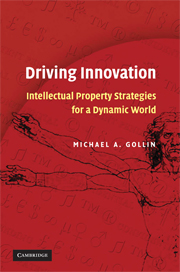Book contents
- Frontmatter
- Contents
- Foreword
- Preface
- Acknowledgments
- Abbreviations
- Introduction: The Invisible Infrastructure of Innovation
- PART I INTELLECTUAL PROPERTY DYNAMICS IN SOCIETY
- PART II BASICS OF MANAGING INTELLECTUAL PROPERTY IN ORGANIZATIONS
- PART III STEPS TO STRATEGIC MANAGEMENT OF INTELLECTUAL PROPERTY
- PART IV STRATEGIES ON A GLOBAL STAGE
- 16 Organization-Specific Strategies
- 17 A Comparison of National Intellectual Property Systems
- 18 Global Challenges for Managing Intellectual Property
- 19 Intellectual Property, Innovation, and Freedom
- APPENDIX A Excerpts from TRIPS Agreement
- APPENDIX B Intellectual Property Non-Policy
- APPENDIX C Intellectual Property Assessment Questionnaire
- APPENDIX D Research Tools for Obtaining Intellectual Property Information
- Bibliography
- Index
19 - Intellectual Property, Innovation, and Freedom
Published online by Cambridge University Press: 05 June 2012
- Frontmatter
- Contents
- Foreword
- Preface
- Acknowledgments
- Abbreviations
- Introduction: The Invisible Infrastructure of Innovation
- PART I INTELLECTUAL PROPERTY DYNAMICS IN SOCIETY
- PART II BASICS OF MANAGING INTELLECTUAL PROPERTY IN ORGANIZATIONS
- PART III STEPS TO STRATEGIC MANAGEMENT OF INTELLECTUAL PROPERTY
- PART IV STRATEGIES ON A GLOBAL STAGE
- 16 Organization-Specific Strategies
- 17 A Comparison of National Intellectual Property Systems
- 18 Global Challenges for Managing Intellectual Property
- 19 Intellectual Property, Innovation, and Freedom
- APPENDIX A Excerpts from TRIPS Agreement
- APPENDIX B Intellectual Property Non-Policy
- APPENDIX C Intellectual Property Assessment Questionnaire
- APPENDIX D Research Tools for Obtaining Intellectual Property Information
- Bibliography
- Index
Summary
This concluding chapter looks at the relationship of innovative individuals and their societies, the significance of innovation to freedom, and the role of intellectual property in maintaining that freedom. The concepts and strategies presented in this book can help individuals, organizations, and nations improve the world through the power of innovation.
Innovation plays a central role in social welfare, and intellectual property has developed as a tool for driving and channeling innovation, by balancing access and exclusivity. How that balance is struck affects both individual organizations and larger communities and nations.
Intellectual property remains controversial. Yet it is and has long been a fundamental instrument of innovation and even personal freedom, and its crucial role will surely continue well into the future.
Nobel laureate economist Amartya Sen argues that national development goes beyond economics or technological progress, and should be seen “as a process of expanding the real freedoms that people enjoy,” including facilities for education and health care as well as political and civil rights. Sen points to freedom of expression and action, freedom to exchange words, goods, and gifts, as basic liberties, part of the way human beings interact with each other unless prevented from doing so. Economic wealth is only one means for achieving freedom in a long and healthy and happy life. Freedom is increased by political liberties, social opportunities, and the enabling conditions of good health, basic education, protective security, and the encouragement and cultivation of initiative.
- Type
- Chapter
- Information
- Driving InnovationIntellectual Property Strategies for a Dynamic World, pp. 342 - 345Publisher: Cambridge University PressPrint publication year: 2008



